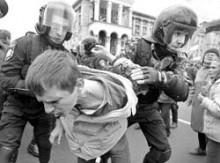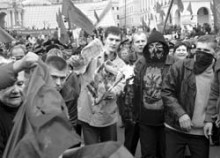Calls for shaking hands will not reconcile soldiers of the Soviet Army and the Ukrainian Insurgent Army, as evidenced by the events in downtown Kyiv last Saturday, marking the UPA’s 63rd anniversary. In fact, that the festivities would not pass without scandal was evident long before national patriotic columns started forming on Kyiv streets with slogans demanding recognition of UPA as a combatant during WWII. Communist organizations and Natalia Vitrenko’s Progressive Socialists made public knowledge their intent to act that day against the “rehabilitation of OUN-UPA structures and against the encroachments on Ukraine’s canonical Orthodoxy.” They lined up on Khreshchatyk St. at nine in the morning with all the attributes, flags of the communist party and the Russian Federation. The national patriotic forces were represented by UPA veterans, Rukh, party Pora, other patriotic organizations, and several clergymen. They were confronted by some 8,000 leftists. Instead of greeting each other and exchanging memories they started shouting insulting accusations and in some places fistfights between young radicals on both sides erupted.
In this context one wonders not only about the local authorities allowing this conflict to happen, but also about the Ukrainian government still remaining silent. This looks especially strange with numerous calls for reconciliation, addressing the veterans of both armies. After such confrontations the possibility of handshakes between the veterans looks quite remote.
(Below historian Yuriy SHAPOVAL comments on the historical aspect of the matter)
October 14 is the Christian holiday of the Protection of the Mother of God, the patron saint of the Zaporozhian Cossack Host, which is why this date also marks the Day of Ukrainian Cossacks. It is also believed to be the founding day of the Ukrainian Insurgent Army (UPA) that fought for Ukrainian independence against Nazi and communist dictatorships. 1942 was declared as its founding year. Taras Bulba-Borovets, one of UPA’s founders and the Polissia Sich ataman, called UPA “an army without a state.” The Ukrainian state exists since 1991, but still has no place for this army.
Here’s a true story that seems hard to believe. When the Berlin Wall was still in place, a delegation of Soviet veterans visited the German Democratic Republic. One of them was given the floor during a public gathering. Overexcited, the veteran blurted out without thinking, “Dear German fascist occupants!”
Indeed, what else could this veteran call these people of German nationality? Only “German fascist occupants,” albeit in an apparently friendly context, as defined by the word “dear.”
I would guess that those in power in Ukraine under presidents Leonid Kravchuk and Leonid Kuchma used just about the same salutation with respect to UPA members and participants of the Ukrainian nationalist resistance. This salutation has not changed to this day.
On the one hand, everybody appears to understand that they fought for an independent Ukrainian state, not against it. On the other hand, the current establishment does not dare say this aloud.
In a country where society has no agreement about interpreting the events of its own history, any discussion of major historical problems inevitably escalates into yet another round of domestic cold war with its essentially Manichaean interpretation of the past. In such conditions the warring camps divide the past strictly into good and evil, i.e., into friends and foes. Events are interpreted according to the primitive principle of black versus white without halftones.
This approach was used by the Stalinist regime, whose propagandists coined the label of “Ukrainian-German nationalists.” The communist government was never bothered by the obvious idiocy of this label. All blame was laid at the feet of Ukrainian nationalists. They were even blamed for the fact that Germans never needed an independent Ukraine. The following quotes come from a communist document. Apparently, “Ukrainian nationalism was never national [Sic!],” and insider fighting in the Organization of Ukrainian Nationalists (OUN) was a “struggle among various foreign intelligence cervices.” It also turns out that the nationalists never went underground. Instead, “they were directed to join the resistance movement in order to form a body of their agents in the Red Army’s rear.”
Of course, these allegations were compounded by the mention of the Galicia Division and the atrocities allegedly committed by the nationalists. All of this made it pretty clear how the government and the people it governed were to treat OUN and UPA.
There has been much water under the bridge since then. Archives have opened, though not all of them. Society has learned that most of the atrocities had been wrongfully imputed to UPA fighters, whereas the Soviet government itself unleashed a torrent of crimes in western Ukraine, where it continued to fight “nationalism” tooth and nail until the mid-1950s.
It has become known that between 1944 and 1952 nearly 500,000 persons in western Ukraine were subjected to various forms of reprisals, including firing by death squad. Over 153,000 of them were put to death. According to official statistics, Ukrainian resistance fighters committed 14,500 acts of sabotage and terror, killing at least 30,000 communist officials, military personnel, and civilians. The figures are no doubt horrible. However, you will understand something by comparing them.
The current situation is further complicated by the fact that there is no agreement concerning UPA not only in our society, which is torn apart by political differences, but also among those who are expected to somewhat clear up this matter or at least make a single step toward clarity. However, the question here is not only of sympathy or antipathy toward UPA, but more often of awareness. Consider an example in this connection.
In 2004 Kyiv-based Krytyka publishers put out a book by Lviv-based historiographer Yaroslav Hrytsak, entitled Strasti za Natsionalizmom. Istorychni Eseyi [Passion of the nationalism. Historical essays]. An interesting book, it seemed somewhat suspicious to me, since its cover bears an obscure statement made by Hrytsak himself: “I would like to state that Ukraine has enough nationalism to ensure an adequate (?!) minimum of political stability in the country.” I was even more frustrated to read in The Observer that “Hrytsak is right.”
However, that Hrytsak is not always “right” is clear if only because he confuses dates (according to him Shelest left Ukraine in 1971, while Shcherbytsky presided over the Communist Party since 1973). But this is not the point. The book contains an essay on UPA, which claims that its real founding day is not October 14, 1942. Understandably, the date is not specific, but only symbolic, much like the Soviet Army’s founding day of February 23. However, Hrytsak goes further by timing UPA’s birthday with the carnage in Volhynia in the middle of 1943.
I believe these allegations can be corrected by the book entitled The Organization of Ukrainian Nationalists and Ukrainian Insurgent Army. Historical Essays, published in 2005 by Naukova Dumka publishers under the auspices of the Institute of Ukrainian History at the National Academy of Sciences. The book’s cover says nothing to the effect that its authors “are right.” Nonetheless, this does not reduce the value of their writing. Free from any sentiments concerning OUN and UPA, and, most importantly, free from rigorism, the authors substantially correct Hrystak’s allegations. They illustrate that UPA’s genesis is not tied to the Volhynian “baptism by blood” so directly and plainly as Hrytsak pictures it. UPA did not originate in 1943, and its complex and often entangled history does not cross out what it had done for Ukraine’s good, and not against it.
As we know, after independence Ukraine has not parted with what Germans call “unbewaeltigte Vergangenheit,” or the unmastered past. We have said no rhetorical or symbolical farewell to communism, let alone broken off with it. This is no place to analyze in great detail why this hasn’t happened. More importantly, reexamining UPA’s historical role is part of the process of coming to terms. A realization of this will enable us to cross the line that will finally separate Ukraine from totalitarianism.








